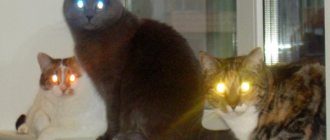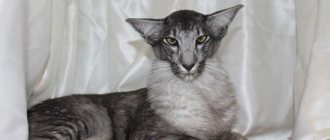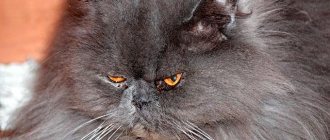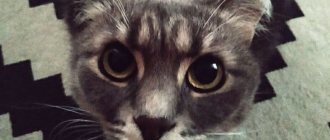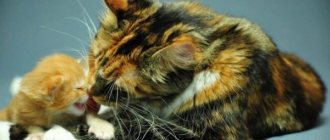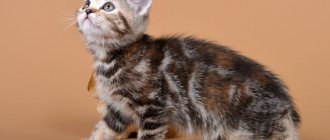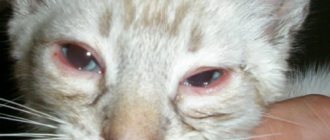People have long paid attention to the peculiarities of cat vision. Ancient man navigated in the dark much better than modern man. But even he was far from a cat, the sensitivity of whose luminous eyes is many times higher than ours. As a result, cats were attributed magical properties, and some peoples even deified them.
With the reign of the medieval Inquisition, difficult times came for cats. They had to suffer greatly due to human superstitions. Now they were considered fiends of hell, accomplices of witches and sorcerers. It is unknown how it would have ended if not for the outbreak of plague carried by rodents. Cats helped control epidemics by eating rats and mice.
Today those days are far behind us, but many people still wonder: why do cat eyes glow in the dark? Do they emit light? Fortunately, now there is no need to guess anymore. Scientists zoologists have long answered this riddle. It's all about the structure of a cat's eye.
Features of the structure of a cat's eye
Cats are nocturnal. It is life with a person that changes their routine and forces them to adapt to the rhythms of family members. Nevertheless, nature takes its toll, and cats are still more awake at night than during the day. In complete darkness, a cat can navigate perfectly not only with the help of hearing, but also thanks to the unique structure of its eyes.
Cats have binocular vision, that is, they see one object at the same time with two eyes, which are located on the front of the face.
It is important for cats to focus their gaze on prey so as not to go hungry
By comparison, herbivores have peripheral vision. That is, the eyes are located on the sides of the skull. They have a viewing angle of more than 320 degrees, which allows them to notice danger in time. A cat's viewing angle reaches 285°, but it is more important for predators to focus their attention on one object - the prey.
A cat's eye consists of 3 layers:
- Fibrous - the outer layer of the eye. They form a fibrous sheath of collagen fibers and protein elastin. The outer layer of the eye is made up of the sclera, which covers approximately 3/4 of the eye's area, and the cornea, which covers the remainder. The function of the cornea is to receive light and transmit it inside the eye for subsequent processing.
- Vascular. It is located immediately behind the fibrous layer and forms a middle layer penetrated by tiny blood vessels. They organize the nutrition of eye tissues with various substances and oxygen. In front of the middle layer is the ciliary (ciliary) body. Next comes the eye lens, which is held in place by the muscles of the ciliary body.
- The retina is the third, inner layer. Consists of light-sensitive cells that are responsible for converting light into nerve impulses for subsequent transmission to the brain via the optic nerve. In cats, like in humans, there are two types of photoreceptors: rods - provide light reception, transmit it through themselves, which forms vision;
- Cones - responsible for image clarity, the ability to see small details and color perception.
The iris is located in front of the ciliary body. This is the colored area of the eye. It divides the eye into two chambers: external and internal. The color of the iris is determined by the amount of pigment. It is finally formed by the age of two. This is why kittens are born with blue eyes, and by the age of one month their color begins to change.
The cat's eye is a very complex and delicate organ, it is made up of many functional parts that together provide the cat with the ability to see.
In the center of the iris there is a black pupil, which changes its size with changes in the level of illumination to regulate the intensity of the light flux entering the eyes: it narrows in bright light, and in dim light it expands to let in maximum light.
The vertical pupil allows different species of animals to see equally well both at night and during the day
Tapetum and its main function
The main difference between the structure of a cat's eye and a human's is the presence of another special layer - tapetum lucidum. The tapetum is located at the back of the eyeball and reflects light not absorbed by the photoreceptors back to the retina.
The tapetum is a kind of “mirror” created by nature. This is the culprit behind the mysterious glow of cat’s eyes. Or rather, a cat’s eyes themselves do not glow in the dark, but as soon as a certain amount of light hits them, they reflect it like a mirror.
Humans also have a tapetum, but only another variety of it - tapetum nigrum, which is practically devoid of reflective pigment.
Cat's eye color spectrum
Cat eyes come in a variety of shades. But there are 4 main colors: yellow, green, blue and copper.
All kittens are born with blue-gray eyes. With age (starting from 1 month) their color changes. By the age of one year, a cat’s iris is at its most saturated, but by old age it fades. In purebred cats, eye color is very often linked according to the laws of genetics with color or with belonging to a particular breed.
For example, all color point cats have blue eyes. These are not only Siamese cats, but also Persians, British, Neva Masquerade and representatives of some other breeds.
A typical combination of color point color and blue eyes is the Thai cat.
Cats also have heterochromia, that is, eyes of different colors. Mostly white animals have this feature. This trait is inherited. By the way, heterochromic eyes glow in the dark in two different colors.
This is actually true. My mother has a cat with heterochromia. I don’t know to what extent this trait was passed on to him by inheritance; he was one of the kittens found in the trash and raised by my cat. We noticed his different eye colors after he was thoroughly licked by my dog when he was a month old. So heterochromia could be a consequence of injury, although vision was not affected. His eyes glow in different colors in the dark: blue - red, brown - green. I'm not very impressionable, but it looks at least unusual.
Other Features
For a long time it was believed that cats see everything in black and white. But recently the opinion of scientists has changed. Studies of the structure of the cat's eye have proven that cats are able to distinguish colors. Of course, they do not need the entire range of colors available to humans. But a cat, for example, distinguishes 25 shades of gray, but does not perceive green and does not see red at all. All shades of blue and yellow are available to the cat; the cat sees black well.
Some scientists believe that cats are color blind.
Special feature for hunters
The cat's eye is proportional to the human eye, but has a layer of reflective cells known as the tapetum. The large size of the eyes and tapetum help the cat to see movement and objects better in dim lighting.
The tapetum, located between the optic nerve and the retina, acts like a mirror. It reflects light, and this gives the cones and rods located in a cat's eyes another opportunity to absorb the limited amount of light available at night.
This anatomical feature proves to be an asset for animals that hunt at dawn and dusk. It was transmitted to a cat domesticated several thousand years ago from its wild ancestors.
Dr. Miller explains that the glowing eyes of many animals are designed for low light. Dogs, cats, cattle, deer, horses, and ferrets have this type of vision. However, humans and primates do not have a tapetum because they are more active during the day. Our retina is designed for brighter lighting.
Cat eye glow process
As mentioned above, a special layer, the tapetum, is responsible for the glow of the eyes in the dark. This interesting coating of the choroid is somewhat similar to mother of pearl. The smallest particles of light that the photoreceptors could not catch fall on the mirror surface of the tapetum and return to the retina. This is how the glow occurs. The tapetum is colored yellow or green, and in blue-eyed felines it is red.
By the way, in absolute darkness cats are completely blind. They are forced to rely only on their hearing and move with the help of another unique organ - vibrissae (special hard hairs that perform the function of touch, a kind of cat navigation system).
In complete darkness there will be no glow in the eyes. For this effect to occur, the slightest light source is required. It’s interesting, but the glow of a cat’s eyes repeats the physical process of releasing sunbeams.
The glow of a cat's eyes in the dark is based on the same reflection of light as when launching a sunbeam through a mirror
Video: why cats' eyes glow in the dark
Mysterious night light
Our purrs love to lounge on a soft sofa or chair during the day and doze off, phlegmatically watching the movements of their owner. Fluffy couch potatoes spend the whole day in a relaxed state. But at night, cats awaken the genes of their wild cat counterparts, night hunters. And the cats go on mischief, scaring those around them with their brightly glowing eyes. Why do they glow like xenon?
Scientific explanation
Thanks to the glorious pedigree of their ancestors, cats have a special eye structure that helps them catch the reflection of different sources in the dark. The unique covering of the choroid, reminiscent of mother-of-pearl, helps purrs in this. This layer is called the “tapetum” and is located behind the retina.
The tapetum mirrors images seen by a cat in the dark and gives special sensitivity to the cat's gaze (a cat's eye is 8 times more sensitive than a human's). The color of the mirror shell is green or yellow (in Siamese cats the tapetum has a soft crimson tint).
Physics claims that cats have absolutely no magical properties, and their glowing eyes are the merit of the tapetum. When the mirror layer reflects the light beam falling on it, this phenomenon occurs, allowing night hunters to pursue prey at dusk.
In complete darkness, cat's eyes do not glow! For a mysterious effect, you need the reflection of the moon or stars. Only when the cat's gaze catches the light source, then their eyes turn on as if from electricity.
Do all animals have this phenomenal feature? This ability is endowed not only by representatives of the cat world - in the dark the eyes of some fish, crustaceans and predatory spiders glow. Only the glow of their eyes is milky white or violet-red.
Myths and legends
Because of its ability to reflect light, people attributed the unfortunate purr to the messenger of the devil. Poor cats were oppressed and poisoned. The countries of medieval Europe were especially successful in this - in a dark time, furry creatures were classified as evil spirits and drowned/burned along with the rest of the “sorcerers” and “witches”.
Only huge infestations of rats, bringing with them deadly diseases, sobered people up, and the purr received rehabilitation. What does mysticism say about magical luminous vision?
Ancient Egypt.
The graceful animal was the faithful companion of the goddess Bastet, who lived on the Moon. Every night the deity descended to earth and protected people and their livestock from attacks by predators. But Bastet could not always visit the land - her duties included other matters. In order not to leave people unattended, the goddess sent her faithful servant, a graceful cat, to Earth.
Since then, the cat has lived next to people, treated them, protected them, and every night reported on completed tasks to its mistress. At these moments, the animal’s eyes “turn on” - she communicates with the mistress.
For the ancient Egyptians, the purr was a symbol of fertility, life and well-being. For the murder of a fluffy, the culprit was punishable by death. When a pet died a natural death, family members shaved their hair and pulled out their eyebrows as a sign of grief. The deceased cat was embalmed and buried with honors in special cemeteries.
Ancient Rome.
Proud Mediterranean people associated the cat with independence and freedom. The inhabitants of Italy had a legend that one evil and cruel Roman kept a circus consisting of animals. The poor animals suffered in captivity and dreamed of escape. Only a fearless cat was able to fulfill her cherished dream - on a gloomy night she gnawed through her bonds and rushed to freedom.
The Roman goddess of freedom Libertas, admiring the animal's love of freedom, gave the cat an amazing feature - to illuminate its path with its eyes. Since then, the independent creature received complete freedom and could choose its own owners. And at night, the cat’s eyes glow as if from electricity, reminiscent of a fearless escape.
Japan.
According to the Japanese hypothesis, the cat was endowed with this feature by the Supreme Gods and made her the patroness of the greatest temple “Maneik-Neko”, a sanctuary of good luck and happiness. The mystical animal walks near the temple at night and if her luminous gaze touches a person, he has the great honor of being caressed by fate.
How to explain to children
While schoolchildren are able to understand the structure of a cat’s eye organ and the ability of animals’ eyes to glow at dusk, this is still difficult for kids. What to answer to the little ones, why do cats’ eyes glow in the dark? Professor Pochemushkin gets down to business with his collection of educational cartoons for the little ones with answers to all questions.
But, if there is no video at hand, and the baby stubbornly demands an answer? Make up a fairy tale!
“Once upon a time, in a small village there lived a cute cat. She was friends with a kind boy. And then one day her little friend fell ill. And only magic berries growing in the swamp could help him.
The brave kitty set off on a long journey to the gloomy swamp to collect a magic potion. But it was so dark and scary! The little animal got lost in the darkness and began to cry. His cry was heard by the mistress of the night - the powerful Moon. She looked out from behind the cloud and asked what happened.
Having learned about the cat's bold intention, the Moon gave her the ability to see in the dark, illuminating the path with the light of her own eyes. The animal found the magic berries and soon returned to the sick boy. The human friend recovered, but cats have retained this ability ever since. The eyes of cats glow at night with a magical, fairy-tale light.”
You can come up with another fairy tale using your favorite little toys, hobbies, and cartoons in the story.
So is there mysticism in glowing cat eyes? You decide. The fluffy purr will not lose human love and care. Mysterious and independent, the cat will always be an adored pet.
Often, to an outside observer, it seems that cats’ eyes “glow.” In fact, this returned light flux looks like the glow of the eyes. That is, the glow of a cat’s eyes is nothing more than a reflection of the light flux that entered the animal’s eye through the pupil. Moreover, cats' eyes can glow in different colors.
Why do cat eyes
glow
different colors? The fact is that the apetum covering the fundus of animals looks like mother of pearl or shiny fish scales. And depending on the impurities of pigments, it may have a green, blue, yellow tint. This is where the eyes of a cat or dog “glow” in green, blue or yellow (Fig. 1).
Fig.1
Why do the cat's eyes glow in the photo?
A cat's eyes can also glow red. This is due to one feature of the placement of the tapetum. This reflective membrane can cover the entire fundus or only part of it. Have different shapes - triangle, rhombus, crescent.
And then a very interesting effect is obtained - the tapetum gives, say, a rich green reflection, and where it is not there, the fundus of the eye will reflect a weaker red color
.
By shooting with flash, you can get a picture in which the eyes of a dog or cat will glow in different colors. Moreover, there may be cases when two colors are visible in one eye at once. This means that the tapetum in this case covers only part of the fundus (Fig. 2).
Fig.2
The cat's eyes glow in different colors
Therefore, when owners of cats and dogs say that their pets have eyes of different colors, the reason may be due to the characteristics of the tapetum.
Thus, the eyes of cats “glow” due to the reflection of incoming light from the tapetum covering the fundus of the eye.
To add comments you need to register on the site.
In daylight, cats become apathetic. They can bask in the summer sun for hours without moving. In winter, sloths can spend the whole day in a cozy soft chair, closer to the radiator. But with the onset of dusk, their behavior changes. Murlyka forgets that only recently he was too lazy to even open his eyes, and begins to show activity, which does not always please sleeping family members. When night falls in cats, the genes of their wild ancestors wake up, going out to hunt at sunset. It was for effective night hunting that Mother Nature provided a special structure for the eyes of the entire cat tribe, capable of capturing the faintest light: moonlight, star rays or the reflection of a distant flame.
Lack of glow in the cat's eyes
The lack of glow in the eyes should alert owners. The cause can be anything: internal diseases and various injuries.
Is it a pathology?
The absence of glow is a direct indication of the development of pathological processes in the body. This pathology occurs against the background of a lack of certain substances. At the same time, the functioning of the lenses and the entire layer deteriorates. The sulfonic acid taurine and a number of other amino acids are responsible for the bright glow of the eyes. Cats get taurine from food of animal origin. Unlike other animals that can produce taurine on their own, cats do not have this ability. Therefore, the deterioration in the brightness of the glow or its absence directly indicates an acute shortage of this element.
How to treat
To prevent the occurrence of pathological conditions of the eyeball, namely vision problems, it is necessary to give the cat vitamins containing taurine. As a rule, this substance is included in many foods or is contained in complex dietary supplements for cats. But you shouldn’t solve the problem yourself by adding dietary supplements to your pet’s diet; you should first consult with a veterinarian.
Vitamins for cats with taurine will compensate for the lack of this amino acid in the pet’s body.
Do I need to contact a veterinarian?
If you suspect problems with your pet's vision, you should show it to a specialist. Unfortunately, many eye diseases occur hidden and are noticed by owners already at a critical stage, when it is almost impossible to do anything.
Of course, you shouldn’t chase a cat around a dark apartment, but you can take at least a couple of pictures with a flash. The absence of “flashlights” in the photo is a direct indication of a visit to the veterinarian.
The eyes of a cat with healthy vision will definitely glow in a photo with a flash.
Diagnosis of diseases and their treatment
Symptoms and treatment of vision pathologies in cats depend on the causes of their development. Redness of the eye occurs in most eye diseases, so only a doctor can determine exactly what triggered the development of redness.
Both veterinary clinics and specialized ophthalmological centers for animals provide assistance with red eyes in pets. Before seeking veterinary help, it is advisable to study everything about the clinic - doctors, work schedule, services. You can also call a veterinarian at home, but in this case you need to visit a clinic to diagnose an ophthalmological disease.
The doctor will examine the animal, prescribe all the necessary tests, and, if necessary, diagnostic hardware methods. Treatment tactics depend on the diagnosis made by the veterinarian. In no case should you delay therapy, as many diseases progress rapidly and can lead to serious complications for the cat’s vision. Some pathologies can affect other organs of the animal, significantly worsening its well-being.
In the initial stages of the disease, the use of drops and ointments for the eyelids is considered effective. In the most severe cases, treatment is performed surgically.
Prevention
Regular eye care for a cat is the key to its health and excellent vision. Basic rules of prevention:
- You need to carefully ensure that when playing in the presence of another pet, the organ membranes are not damaged or injured.
- When bathing your pets, it is very important that soap or shampoo does not get into the eyes, as this can cause irritation.
- For hygiene procedures, it is recommended to use a gel or other drug that does not cause allergies.
- When tear fluid is released, it must be removed with sterile cotton swabs.
- It is very important to ensure that the fur does not get into the eyes under any circumstances; if necessary, it should be trimmed 1-2 times a month.
Redness and swelling are the first signs of inflammation. If the owner notices that the cat has begun to actively scratch the eye area, it is recommended to instill artificial tear preparations behind the eyelid 1-2 times a day. They effectively relieve dryness and irritation.
If such a medicine is not at hand, it can be replaced with regular olive oil. The use of the drug Ciprovet is also recommended - it is an effective antibacterial and anti-inflammatory agent that relieves pain and discomfort, destroys pathogenic bacteria and viruses.
If, after applying all preventive measures, swelling and redness of the cat's eyes can be seen, it is necessary to protect the animal from constantly scratching the diseased organ. To do this, your pet should wear a special protective collar, and then immediately seek help from a veterinarian.
The best prevention of ophthalmic diseases in cats is an extremely caring and attentive attitude to the health of your pet. When the first signs of the inflammatory process appear, you must seek veterinary help. Only in this case can the cat’s health and visual acuity be preserved.
Legends and superstitions associated with glowing eyes in cats
There are many legends associated with cats and their eyes. There are those in which cats are considered evil creatures, but there are also opposing legends:
- In medieval Europe, cats were hated: they were considered messengers of the devil. This was due to the animal’s nocturnal lifestyle and the mystical glow of its eyes. These animals were subjected to widespread destruction. And only the invasion of rats and mice gave cats amnesty and the right to exist.
- There is a cat's eye stone, which is surprisingly similar to the eyes of a small predator. But the reputation of the stone is disgusting. Legend has it that after the Flood, when people were very pious, Satan could not find his fans. Then the devil created a stone that had an amazing glow, sparkled and shimmered. With its beauty it fascinated the finder. But long admiration of the stone awakened anger and hatred in the human soul. This is how the devil met the first sinner. The beauty of the stone fascinated people, and everyone who decided to wear it became invisible to God, but clearly visible to the devil. Left without God's supervision, the unfortunate man fell into satanic captivity. This legend has long been forgotten, but people are still wary of this stone. In addition, they love to use it for mystical rituals and ceremonies.
After processing, a luminous vertical stripe remains in the center of the gem, which makes the stone look like a cat’s eye
- In ancient Egypt, there was a legend about the goddess Bastet, who lived on the moon and protected people from all evil and disease. But the goddess could not always descend to earth and help people. Then she sent her assistant, the cat, to help. Since then, the cat has been with people all the time: it cures illnesses, puts babies to sleep by purring for them, and awakens its owners during sandstorms. And having completed its business, the cat reported to the goddess about what had happened. This communication took place at night, when the moon appeared. At this moment, the cat's eyes began to glow like two small moons.
- In ancient Rome there was a legend about an evil and cruel circus owner. His animals were imprisoned, he abused them in every possible way. And only the cat was able to get free. On a gloomy night, she gnawed through her bonds and escaped to freedom. The goddess Libertas, admiring the courage and bravery of the animal, gave him the amazing opportunity to illuminate his path with his eyes. Since then, the cat has become independent and can choose its own owners. And the mystical glow reminds of fearless escape.
- According to Japanese legend, the cat was given glowing eyes by the Supreme Gods. They made her the patroness of the Maneki-Neko Temple, a place for finding good luck and happiness. According to legend, the cat makes the rounds of the temple at night. And if her luminous gaze touches a person, then he becomes the favorite of the gods, and luck will accompany him everywhere.
List and description of possible causes
First of all, it is recommended to examine the iris and lens to exclude possible damage to the organ of vision. If everything is in order, then you can switch to redness of the skin around the eyes, which can be caused by the following reasons:
- Injury. Scratches, cuts, and bruises may be accompanied by swelling and redness of the skin. This is especially true for cats that have access to free range. You don’t have to touch the bruises; they go away on their own within a couple of days. It is better to treat scratches or deep cuts with antiseptics (miramistin, chlorhexidine) to prevent infection from entering the wound. In rare cases, deep cuts need to be sutured. This can only be done in a hospital setting with the use of painkillers and special instruments.
- Eosinophilic granuloma. A common phenomenon among decorative breeds. It can occur in different forms: ulcers, plaques and nodules. Deep ulcers most often appear on the mucous membrane, which prevent the animal from chewing food. Lesions may also appear on the lips, chin, ears and near the eyes. Redness of the skin and swelling are not accompanied by pain even with pressure. Eosinophilic granulomas still remain a poorly understood disease that is prone to regression. For single lesions, changing the brand of food and bowl can be used as therapy. If this does not help, then they try to identify the potential allergen not in the diet. This could be house dust, the hair of other animals, or exposure to chemicals (washing powder, detergent, etc.). For deep and multiple lesions, steroid therapy can be used. A combination of antihistamines and hydrocortisone also has a good effect. As for the prognosis for eosinophilic granulomas, they will depend on whether a potential allergen is found or not. If yes, then you can count on stable remission. If not, then treatment is symptomatic; exacerbation can occur at any time.
- Follicular conjunctivitis. A common condition that causes cats to develop purulent discharge from the eyes. At the initial stage, it may manifest itself in constant tearing, which causes redness around the eyes. There are many reasons for the development of follicular conjunctivitis, ranging from allergies to injuries to the organ of vision. To begin with, they try drug treatment using drops and ointments (Iris, Korneregel, Tobrex). If there is no improvement, then surgical intervention is considered. In some cases, it is possible to perform curettage without the use of anesthesia. But, in most cases, they do not take risks, since the slightest disturbance on the part of the pet can lead to injury, and anesthesia is used during cleaning.
- Pathologies of the cornea. Can lead to different types of conjunctivitis. A cat can get a corneal injury during a fight or play. A double row of eyelashes may also be the cause. This phenomenon is considered hereditary and requires surgical intervention. Injury to the cornea is always accompanied by profuse lacrimation, which causes redness and weeping around the eyes. If itching is present, scratching may cause bald patches to appear in that area. Small corneal ulcers are treated with drops (Ocomistin) and ointments (Korneregel). If the injury is deep, suturing may be required. In isolated cases, removal of the organ of vision may be necessary.
- Allergy. The most common cause of redness around the eyes in cats. In decorative breeds prone to dermatitis, the slightest contact with a potential allergen immediately appears on the face: the eyes become swollen and red, lacrimation, runny nose, and sneezing appear. In rare cases, anaphylactic shock or Quincke's edema may develop. Then the animal must be immediately hospitalized. You need to accept the fact that allergies cannot be cured once and for all, so before breeding decorative breeds (Maine Coon, Abyssinian, Bobtail, British, Sphynx), you need to familiarize yourself with the possible problems of their maintenance. Allergies to food, dust, house plants and other objects found in the house are considered common among these breeds. From an early age, they may develop skin problems (red spots, rashes) and hair loss. The problem can usually be solved by switching to hypoallergenic food.
Why is this necessary?
The cat's glow-in-the-dark eyes provide signal amplification and improved image quality in the dark. This is explained by the fact that a weak ray of light penetrates the retina, is reflected from the tapetum and re-enters the retina, but now enhancing the signal and improving the visibility of the picture.
It is thanks to the built-in amplifier that cats perfectly distinguish objects even in the light of the stars. This allows them to be nocturnal and accurately strike in conditions of almost complete darkness by human standards. A cat is able to see the movement of objects from seven hundred meters away and can distinguish them perfectly from a distance of one to 57 meters.
In the dark, a cat’s eyes glow and at the same time can not blink thanks to the existing third eyelid. It performs protective functions and prevents the eye from drying out, which is achieved by moving fluid.
The human eye responds to bright lighting by making the pupils very narrow (they narrow). In cats, the pupils transform into long narrow slits. This property allows the animal to regulate the amount of light that enters the organs of vision. It is the ability to control the intensity of light that distinguishes cats from other animals.
Previously, there was a hypothesis that cats see all objects as gray. The basis for this conclusion was that this is not necessary, because in the dark all images look in shades of gray. It is now a scientifically proven fact that cats distinguish the color spectrum, but much worse than humans.
Noticing a cat's eyes burning in the dark, a person sees only the reflection of a beam of light reflected from the tapetum.
Who posted
Site administration
People at all times have endowed cats with mystical abilities. In part, this statement is not without meaning, but still, there is a scientific basis for any mysterious phenomena associated with these animals. One of these phenomena, which has stirred the imaginations of people for many centuries of coexistence, is the almost mystical glow of a cat's eyes in the dark.
How to explain to children.
The owners of the furry creature and at the same time parents may notice their child’s tension in the evenings at certain times. For example, a baby absolutely does not want to let a cat into his room at night. Or he tries to avoid contact with his pet altogether. There can be many reasons and you need to deal with them immediately. And a fairly common cause is the glow of the animal’s eyes in the dark, which can frighten the baby.
Cats and children are best friends.
There are different ways to explain to children the reason for glowing cat eyes. Believing families can explain this phenomenon with a legend from their religion. For example, Christians can talk about the Lord who endowed a cat with his light so that it would drive away darkness from its owners.
If the parent does not want to mislead the child and wants to explain everything scientifically, a question arises. How can this be done so as not to break the baby’s brain, but so that he understands everything? And it turns out it's quite easy.
You can show the child a mirror and explain that in the eyes of a cat there is the same small mirror that reflects light, which is why such a phenomenon as the glow of the eyes appears.
Scientific explanation
In the dark, cats' eyes glow due to their ability to reflect light that hits them. By themselves, they are not able to produce any radiation, so in complete darkness there will be no glow. The principle of operation of a cat's visual organs is the same as that of human eyes, but there is one significant difference that causes the glow at night - the tapetum.
The inside of a cat's eyes is covered with a layer of transparent cells called the tapetum. It is the similarity of this layer to a mirror that causes the reflection of light and, as a result, the glow. Even the faintest reflection, passing through the cornea and lens, is not fully absorbed, but is reflected and returned back by a thin beam of light. It is this feature of the structure of the eyes of felines that allows them to see excellently in the dark.
The color of the glow may vary depending on the pigment located in the tapetum
:
- green;
- yellow;
- bluish;
- in Siamese cats it is crimson in color.
A cat's eyes are 7 times superior to human eyes in their ability to discern images in the dark. People may also experience a faint red glow. This is clearly noticeable when photographing using a bright flash.
